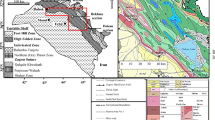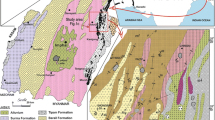Abstract
Carbonate, largely in the form of dolomite, is found throughout the host rocks and ores of the Nchanga mine of the Zambian Copperbelt. Dolomite samples from the hanging wall of the mineralization show low concentrations of rare-earth elements (REE) and roof-shaped, upward convex, shale-normalized REE patterns, with positive Eu*SN anomalies (1.54 and 1.39) and marginally negative Ce anomalies (Ce*SN 0.98,0.93). In contrast, dolomite samples associated with copper and cobalt mineralization show a significant rotation of the REE profile, with HREE enrichment, and La/LuSN ratios <1 (0.06–0.42). These samples also tend to show variable but predominantly negative Eu*SN and positive cerium anomalies and an upwardly concave MREE distribution (Gd-Er). Malachite samples from the Lower Orebody show roof-tile-normalized REE patterns with negative europium anomalies (Eu*SN 0.65–0.80) and negative cerium anomalies (Ce*SN 0.86–0.9). The carbonate 87Sr/86Sr signature correlates with the associated REE values. The uppermost dolomite samples show Neoproterozoic seawater-like 87Sr/86Sr ratios ranging from 0.7111 to 0.7116, whereas carbonate from Cu–Co mineralized samples show relatively low concentrations of strontium and more radiogenic 87Sr/86Sr, ranging between 0.7136–0.7469. The malachite samples show low concentrations of strontium, but give a highly radiogenic 87Sr/86Sr of 0.7735, the most radiogenic 87Sr/86Sr ratio. These new data suggest that the origin and timing of carbonate precipitation at Nchanga is reflected in the REE and Sr isotope chemistry. The upper dolomite samples show a modified, but essentially seawater-like signature, whereas the rotation of the REE profile, the MREE enrichment, the development of a negative Eu*SN anomaly and more radiogenic 87Sr/86Sr suggests the dolomite in the Cu–Co mineralized samples precipitated from basinal brines which had undergone significant fluid–rock interaction. Petrographic, REE, and 87Sr/86Sr data for malachite are consistent with the original sulfide Lower Orebody being subject to a later oxidizing event.








Similar content being viewed by others
References
Annels AE (1989) Ore genesis in the Zambian Copperbelt with particular reference to the northern sector of the Chambishi Basin. In: Boyle RW, Brown AC, Jefferson CW, Jowett EC, Kirkham RV (eds) Sediment hosted stratiform copper deposits. Geological Association of Canada Special Paper 36:427–452
Armstrong RA, Master S, Robb LJ (2005) Geochronology of the Nchanga Granite, and constraints on the maximum age of the Katanga Supergroup, Zambian Copperbelt. J Afr Earth Sc 42:32–40
Asmerom Y, Jacobsen SB, Knoll AH, Butterfield NJ, Swett K (1991) Strontium isotopic variations of Neoproterozoic seawater; implications for crustal evolution. Geochim Cosmochim Acta 55:2883–2894
Bau M (1991) Rare-earth element mobility during hydrothermal and metamorphic fluid-rock interaction and the significance of the oxidation state of europium. Chem Geol 93:219–230
Bau M, Dulski P (1996) Distribution of yttrium and rare-earth elements in the Penge and Kuruman iron-formations, Transvaal Supergroup, South Africa. Precambrian Res 79:37–55
Bau M, Möller P (1992) Rare earth element fractionation in metamorphogenic hydrothermal calcite, magnesite and siderite. Mineral Petrol 45:231–246
Bi X, Cornell DH, Hu R (2002) REE composition of primary and altered feldspar from the mineralized alteration zone of alkaline intrusive rocks, western Yunnan Province, China. Ore Geol Rev 19:69–78
Brookins DG (1988) Eh-pH diagrams for geochemistry. Springer, Berlin, p 176
Fernández-Nieto C, Torres-Ruiz J, Perez IS, Gonzalez IF, Lopez JMG (2003) Genesis of Mg-Fe carbonates from the Sierra Menera magnesite-siderite deposits, Northeast Spain; evidence from fluid inclusions, trace elements, rare earth elements, and stable isotope data. Econ Geol 98:1413–1426
Hanson RE, Wardlaw MS, Wilson TJ, Mwale G (1993) U-Pb zircon ages from the Hook granite massif and Mwembeshi dislocation; constraints on Pan-African deformation, plutonism, and transcurrent shearing in central Zambia. Precambrian Res 63:189–209
Hecht L, Freiberger R, Gilg HA, Grundmann G, Kostitsyn YA (1999) Rare earth element and isotope (C, O, Sr) characteristics of hydrothermal carbonates; genetic implications for dolomite-hosted talc mineralization at Goepfersgruen (Fichtelgebirge, Germany). Chem Geol 155:115–130
Jacobsen SB, Kaufman AJ (1999) The Sr, C and O isotopic evolution of Neoproterozoic seawater. Chem Geol 161:37–57
John T, Schenk V, Mezger K, Tembo F (2004) Timing and PT evolution of whiteschist metamorphism in the Lufilian Arc-Zambezi Belt Orogen (Zambia); implications for the assembly of Gondwana. J Geol 112:71–90
McGowan RR, Roberts S, Foster RP, Boyce AJ, Coller D (2003) Origin of the copper–cobalt deposits of the Zambian Copperbelt; an epigenetic view from Nchanga. Geology 31:497–500
McGowan RR, Roberts S, Boyce AJ (2006) Origin of the Nchanga copper–cobalt deposits of the Zambian Copperbelt. Miner Deposita 40:617–638
Mendelsohn F (1961) The geology of the northern Rhodesian copperbelt. Mcdonald, London, p 523
Muchez PH, Vanderhaeghen P, El Desouky H, Schneider L, Boyce A, Dewaele S, Cailteux J (2008) Anhydrite pseudomorphs and the origin of stratiform Cu–Co ores in the Katanga Copperbelt (Democratic Republic of Congo). Miner Deposita 43:575–589
Nothdurft LD, Webb GE, Kamber BS (2004) Rare earth element geochemistry of Late Devonian reefal carbonates, Canning Basin, Western Australia; confirmation of a seawater REE proxy in ancient limestones. Geochim Cosmochim Acta 68:263–283
Selley D, Broughton D, Scott R, Hitzman M, Bull SW, Large RR, McGoldrick PJ, Croaker M, Pollington N, Barra F (2005) A new look at the geology of the Zambian Copperbelt. Economic Geology 100th Anniversary Volume. Society of Economic Geology, Tulsa, pp 965–1000
Shields GA, Webb GE (2004) Has the REE composition of seawater changed over geological time? Chem Geol 204:103–107
Sutton SJ, Maynard JB (2005) A fluid mixing model for copper mineralization at Konkola North, Zambian Copperbelt. J Afr Earth Sc 42:95–118
Sweeney M, Turner P, Vaughan DJ (1986) Stable isotope and geochemical studies in the role of early diagenesis in ore formation, Konkola Basin, Zambian copper belt. Econ Geol 81:1838–1852
Taylor SR, McLennan SM (1985) The continental crust: its composition and evolution. Blackwell, Oxford, p 312
Veizer J (1983) Trace elements and isotopes in sedimentary carbonates. Rev Mineral 11:265–299
Webb GE, Kamber BS (2000) Rare earth elements in Holocene reefal microbialites; a new shallow seawater proxy. Geochim Cosmochim Acta 64:1557–1565
Wood SA (1990) The aqueous geochemistry of the rare-earth elements and yttrium; 2, theoretical predictions of speciation in hydrothermal solutions to 350 degrees C at saturation water vapor pressure. Chem Geol 88:99–125
Zhong S, Mucci A (1995) Partitioning of rare earth elements (REEs) between calcite and seawater solutions at 25 degrees C and 1 atm, and high dissolved REE concentrations. Geochim Cosmochim Acta 59:443–453
Acknowledgments
The authors acknowledge the technical expertise of Andrew Milton in the measurement of the REE data. The samples were collected with the support of Equinox Minerals and Anglo American PLC. Damon Teagle, Alex Brown, and Massimo Chiaradia are thanked for detailed and constructive reviews of the manuscript.
Author information
Authors and Affiliations
Corresponding author
Additional information
Editorial handling: F. Tornos
Rights and permissions
About this article
Cite this article
Roberts, S., Palmer, M.R., Cooper, M.J. et al. REE and Sr isotope characteristics of carbonate within the Cu–Co mineralized sedimentary sequence of the Nchanga Mine, Zambian Copperbelt. Miner Deposita 44, 881–891 (2009). https://doi.org/10.1007/s00126-009-0254-2
Received:
Accepted:
Published:
Issue Date:
DOI: https://doi.org/10.1007/s00126-009-0254-2




